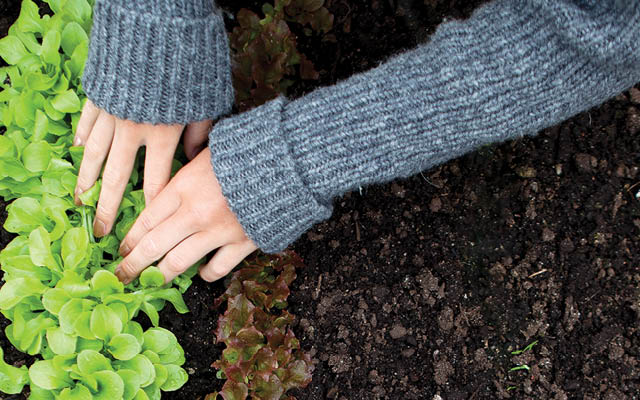My adventures in gardening started in 2013. For Mother’s Day that year, my handy husband surprised me by transforming an overgrown section of our backyard into a garden, something I’d been dreaming about since we bought our home a few years earlier.
With its stone retaining wall and cute little fence, the garden was built into the hillside next to our house, where it would get plenty of afternoon sun. In my mind, I could already see rows of vegetables growing in it.
I plotted out that first year’s plan with visions of pulling weeds while our toddler plucked cherry tomatoes fresh off the vine and our soon-to-be newborn napped in the stroller nearby (I was eight months pregnant at the time).
Lettuces, a variety of tomatoes, green peppers, jalapeños, cucumbers, and lots of herbs made up my first season’s attempt. With guidance from Pinterest and a trowel in hand, I placed those starter plants in the soil, watered them, and went about my day.
Lo and behold, most of those plants began to grow. As someone who had struggled to keep houseplants alive, I was thrilled. As the daughter of a farmer, I felt proud that I could provide fresh produce in this small way for my own little family.
And those visions I’d had? They happened that summer while I was on maternity leave: My older daughter ate those still-warm tomatoes as soon as she picked them, and I pulled plenty of weeds. We enjoyed fresh-from-the-garden salads, topped with fresh herbs and tomatoes, along with enough jalapeño poppers to burst, well into fall.
The green peppers and cucumbers, on the other hand, didn’t do so well — but their early demise inspired what has become my annual gardening experiment. Along with the veggies and herbs that I know thrive in our sandy soil, I also pick one or two new ones to try each season.
Chives, I’ve learned, grow like weeds and are perennial; they’re the first buds to pop up each year. Onions do well, too. Carrots and sweet corn? Not so much.
Last year, I attempted Brussels sprouts, the trendy veggie that all four of us enjoy. They grew, but actual produce never came to be. I blame the pesky rabbit that made its home in our yard for leaving us with bare stalks.
This spring, we’re fortifying the fence, going for round two of Brussels sprouts, and giving beets a shot. Whether they do well or not, I’m excited to get my hands back in the dirt, just as generations before me have done.
As I’m planting and weeding and harvesting, I’m reminded of those times when my sister and I, as kids, sneaked strawberries from the garden of our elderly neighbor, Alice. I can almost taste the fresh green beans and hear the crunch of those crisp pickles made from the cucumbers out of my Grandpa Bob’s farm plot. And there’s nothing quite like homemade vanilla pudding — a much-loved family recipe that has been passed down for years — topped with just-picked raspberries from the bush in my parents’ yard.
As I rinse salad greens, chop tomatoes, and whip up pesto from fresh basil, I can only hope that my children — and all children — will have their own place to dig in the soil someday, whether a simple container garden or maybe even a little farm. (For inspiring stories of small-scale farms, see “Meet Your Farmers”.)
Because while food nourishes us in so many ways (hence a whole issue dedicated to it!), there’s something truly empowering about having a hand in where our food comes from.




This Post Has 0 Comments